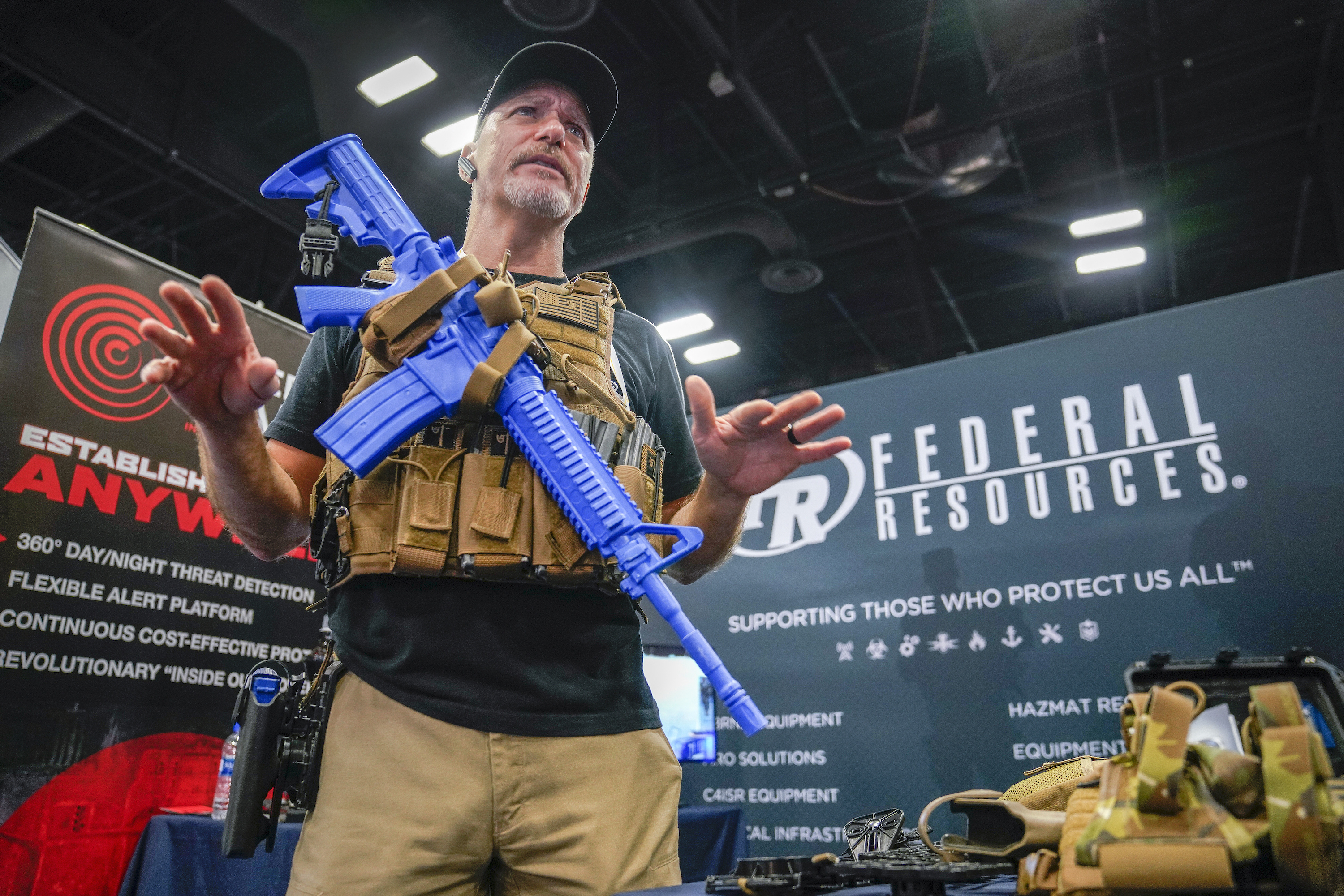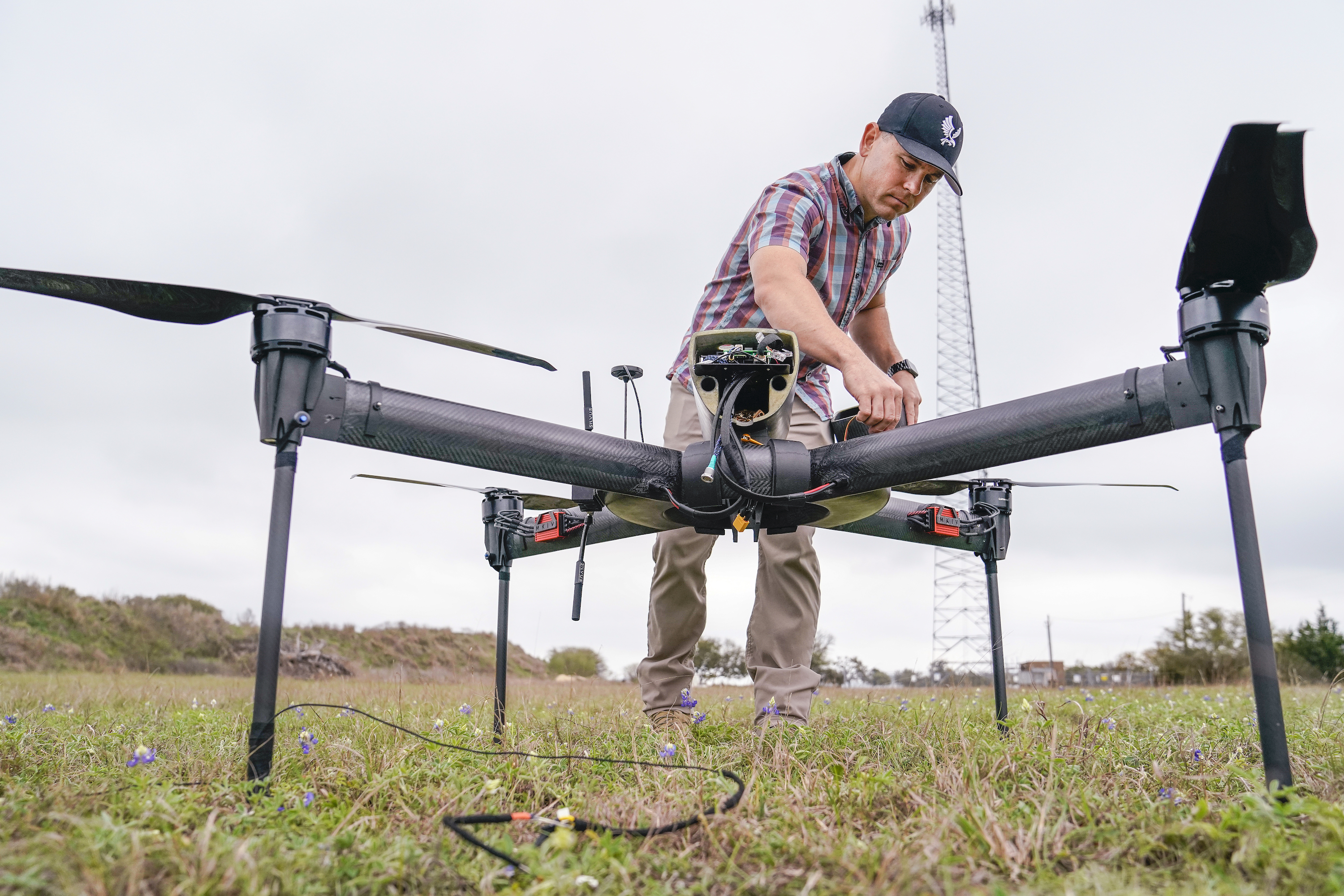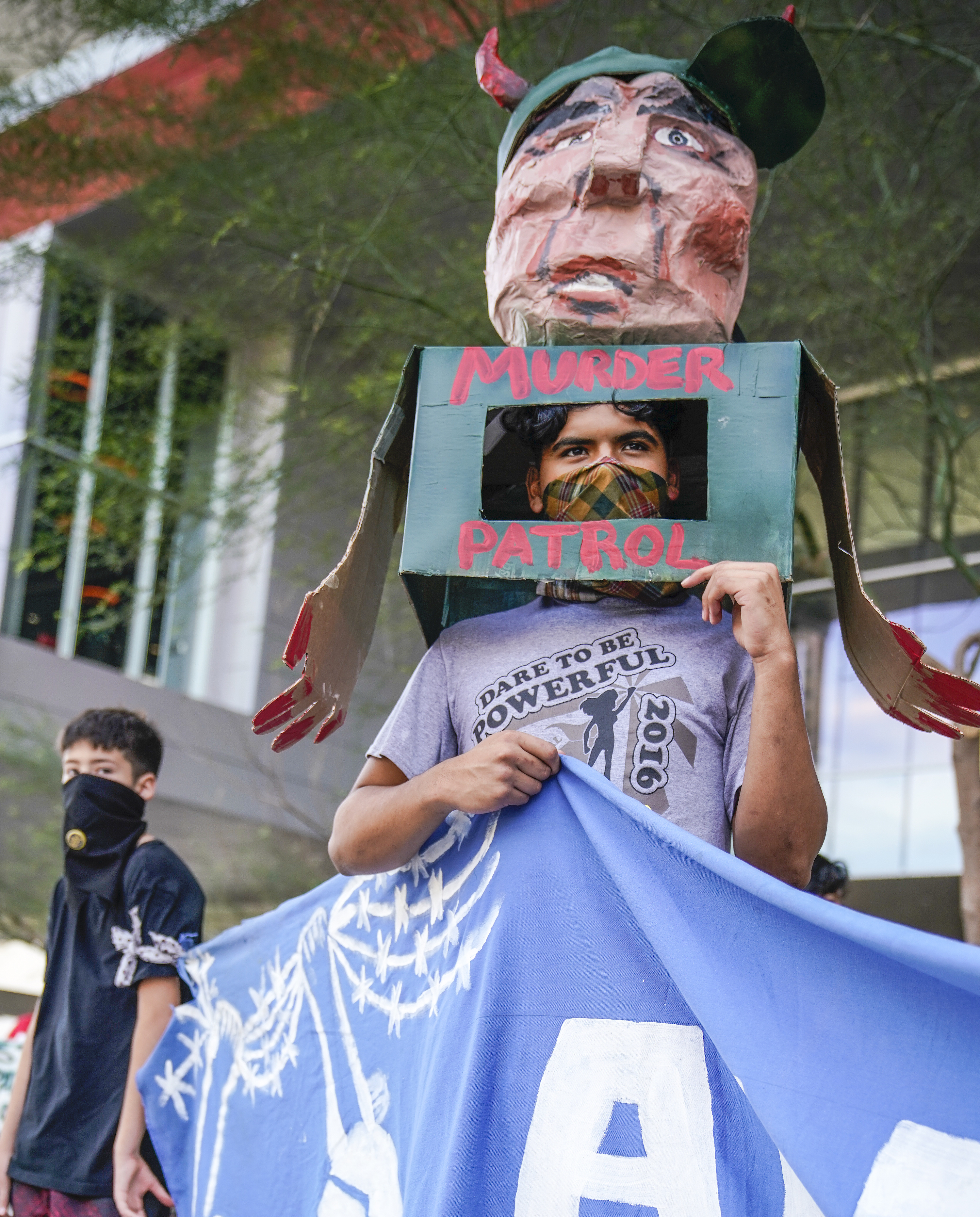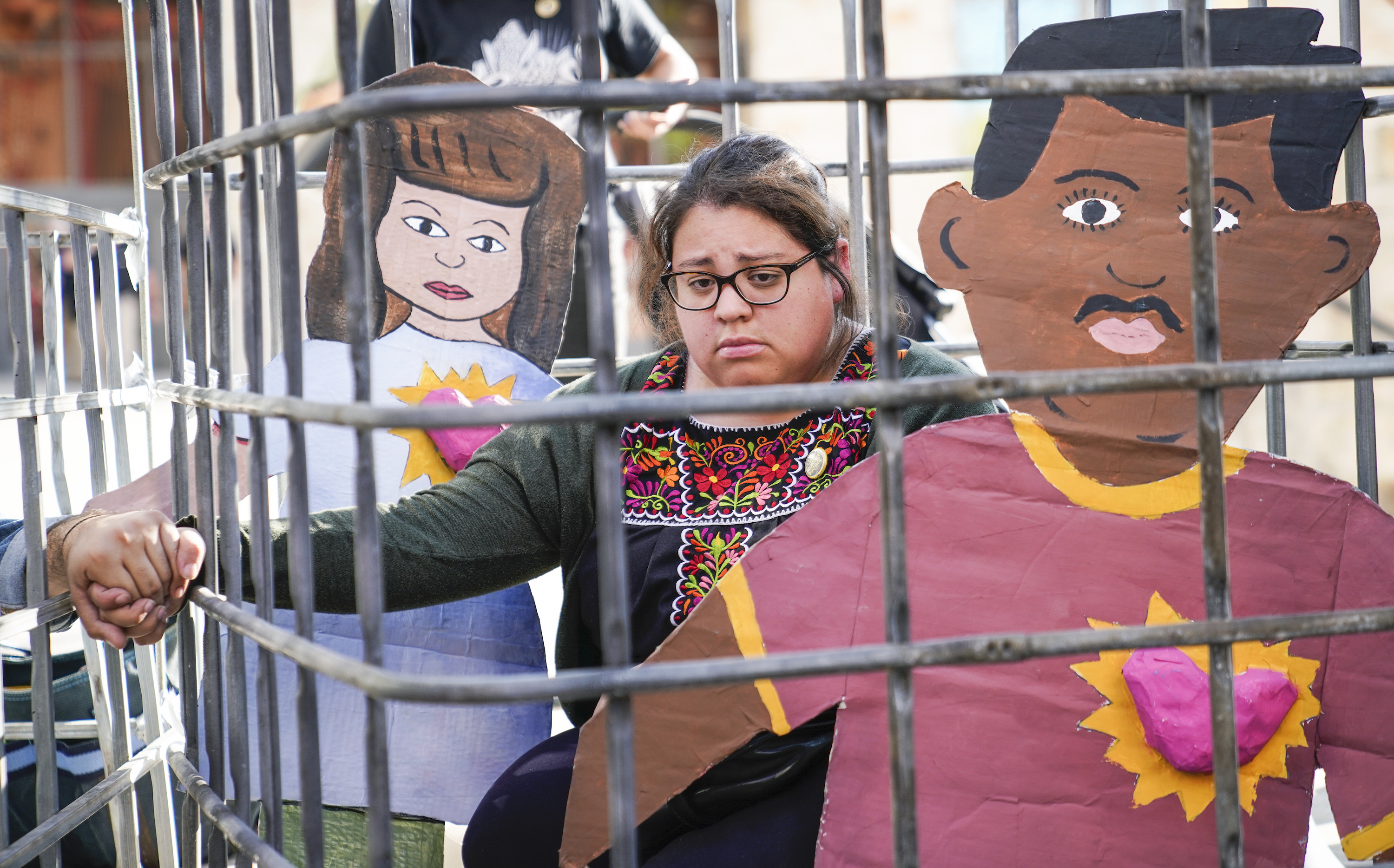On demo day at the Border Security Expo, hundreds of law enforcement agents armed with M16s, automatic shotguns, pistols, and other high powered and military-grade weapons strolled around the grounds at the Bandera Gun Club outside of San Antonio. The sound of continuous gunfire from the “Sharpshooter Classic”—a multi-staged shooting competition put on by the Border Patrol Foundation—combined with the nearby buzz of a $100k surveillance drone hovering above a grass field in Texas Hill Country.
"Our main target was CBP and Homeland Security," Anthony Ibrahim told me. "Specifically, CBP is interested in both the surveillance and remote communications capabilities," added Ibrahim, vice president of Chartis Federal, which has a partnership with the drone company Periscope Aviation.
Ibrahim was demoing Periscope Avatation's MK4 drone, whose low hum was punctuated by the intermittent gunfire from the nearby contest. The Sharpshooter Classic, which "consist of real-life scenarios that border agents and officers face in the field," is one of the draws of the expo, and is perhaps emblematic of the border's militarization. The expo brought more than 100 companies hawking their wares to border patrol agents and top decision makers from the Department of Homeland Security, along with the private border security sector, an industry which has expanded in step with the ballooning budgets of DHS.
The "fully autonomous heavy lifter," as Ibrahim explained, can carry up to 65 lbs and is used for supply delivery and remote communications.
"This setup allows us to rapidly stand up the radio and LTE communications capabilities in remote areas with little or no infrastructure," Ibrahim said referring to what could be a mobile cell tower used in remote areas.

Back inside the expo, hundreds of presenting companies sprawl across the exhibition floor. Their booths, organized in categories such as "Facial Recognition," "Night Vision/Thermal Imaging," and "Unmanned systems,” display the latest in border security technology. From long-range infrared cameras and AI-driven biometrics to fully autonomous drones (UAVs) each poised to be part of the expanding surveillance and monitoring technologies of the virtual wall.
"We use technology everyday along our borders and in the skies," says Deputy Customs and Border Protection (CBP) Commissioner Robert Perez, speaking to a packed auditorium at the expo. "We have to be aggressive in protecting our borders through things like video surveillance and unmanned aircraft systems."
The expo reflects the close relationship between CBP and the private border security industry (companies were awarded over $27 billion worth of CBP contracts between 2006-2018) while also providing a telling lens into the future of border enforcement and the expanding use of surveillance and monitoring technologies by CBP.

Presenting at the auditorium on the first day of the expo, Perez said the agency has a "$15.6 billion dollars budget" that includes "buckets of dollars for a few things that I thought y'all might be interested in."
Companies like Easy Aerial and Chartis Federal want to make sure they get a piece of the pie.
"Drones are going to play a large role in border security," says Mathew Linden from Easy Aerial, a drone company hoping to secure a contract with Customs and Border Patrol for surveillance and remote communication on the Border. "It's just a matter of time."

Linden demonstrated Easy Aerial's SAMS drone, which emerged from a giant chest (the doors of which opened like some futuristic pandora's box) small enough to fit in the back of a pickup truck.
"The idea is to take as much of the person out of drone operation," Linden said, adding that the drone could be programmed to fly perimeter sweeps, respond to external alarms, sent to a location with a click of a button, and equipped with control cameras that can "track people all without the need for remote control."
While the emphasis on the physical barrier has gotten much attention of late, the growth of border security technologies, particularly the potential expansion of drone usage, is equally profound and for some just as troubling.
"When you walk into the expo hall and see robots and drones, biometric systems, and sophisticated infrared cameras, it is almost a crystal ball of what is being imagined in the borderlands," says Todd Miller, author of the report "More Than A Wall: Corporate Profiteering and the Militarization of US borders."

"It's even more insidious in some ways. These technologies have the same goal as the wall," Miller said, referring to the policy of prevention through deterrence that has increasingly funneled undocumented immigrants into more remote and deadly crossing areas. "But somehow, the advanced cameras, biometrics, and drones are framed as kinder more humane."
Outside the convention center, activists protested the militarization of the border, and the crackdown on immigration more broadly.
"This is the technology of militarization and human suffering," Debbie Hernandez of the Organization RAICES, said at the protest outside the convention center on the second day of the expo.
Many have raised concerns over the use of drones and other technology for the widespread surveillance of unaware Americans by Border Patrol, the nation's largest law enforcement agency that already has expansive powers in the borderlands.
"At the conventions, we've already seen drones equipped with facial recognition cameras, airborne biometrics, license plate readers and thermal imaging technology," said Dave Maass, a senior investigative researcher at the Electronic Frontier Foundation, noting the surveillance potential of these drones.

CBP is not required to get a warrant to use drones for surveillance, and according to a report by the CATO institute, the surveillance limitations of high altitude drones such as the Predator do not apply to the types on display at the border security expo. Last week, CBP was caught surveilling protesters with a Predator drone in Minneapolis, well outside of its border patrol zone.
As the report states, the Federal Aviation Administration requires predator drones to fly between 19k and 28k feet, a height in which the camera cannot identify exact height, weight, facial image, etc. "These limitations would not apply to the smaller drones that CBP is currently testing. Small drones fly closer to the ground and can identify people's ethnicity, height, weight, and hairstyle," according to the report.
"I hate to use the cliche, but it's very Orwellian," says Miller. "This technology applied to the Border is part of the same strategy of exclusion. The end goal is the same sort of policing with the same outcomes."
from VICE https://ift.tt/2UwrO1W
via cheap web hosting
No comments:
Post a Comment